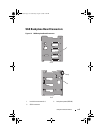
Glossary 181
Fibre Channel — A high-speed network interface used primarily with networked
storage devices.
flash memory — A type of electronic chip that can be programmed and
reprogrammed using a software utility.
FSB — Front-side bus. The FSB is the data path and physical interface between the
processor and the main memory (RAM).
FTP — File transfer protocol.
g — Gram(s).
G — Gravities.
Gb — Gigabit(s); 1024 megabits or 1,073,741,824 bits.
GB — Gigabyte(s); 1024 megabytes or 1,073,741,824 bytes. However, when referring
to hard-drive capacity, the term is usually rounded to 1,000,000,000 bytes.
graphics mode — A video mode that can be defined as x horizontal by y vertical pixels
by z colors.
host adapter — A controller that implements communication between the system’s
bus and the peripheral device, typically a storage device.
hot-swap — The ability to insert or install a device, typically a hard drive or an internal
cooling fan, into the host system while the system is powered on and running.
Hz — Hertz.
I/O — Input/output. A keyboard is an input device, and a monitor is an output device.
In general, I/O activity can be differentiated from computational activity.
IDE — Integrated drive electronics. A standard interface between the system board
and storage devices.
iDRAC — Internet Dell Remote Access Controller. A remote access controller that
uses the Internet SCSI protocol.
IP — Internet Protocol.
IPv6 — Internet Protocol version 6.
IPX — Internet package exchange.
IRQ — Interrupt request. A signal that data is about to be sent to or received by a
peripheral device travels by an IRQ line to the processor. Each peripheral connection
must be assigned an IRQ number. Two devices can share the same IRQ assignment,
but you cannot operate both devices simultaneously.
iSCSI — Internet SCSI (see SCSI). A protocol that enables SCSI device
communication across a network or the Internet.
book.book Page 181 Wednesday, August 19, 2009 4:40 PM


















